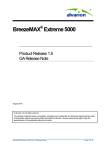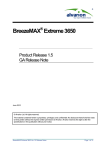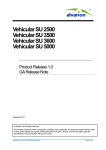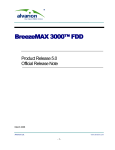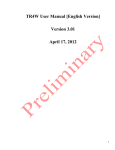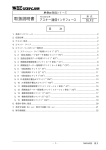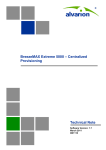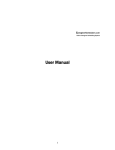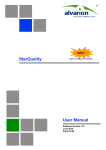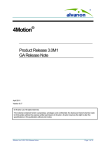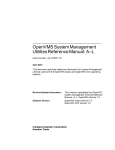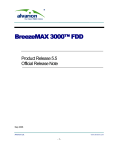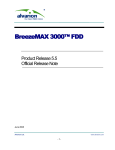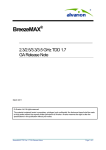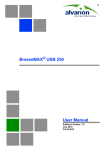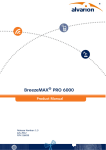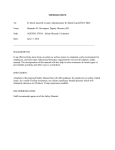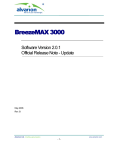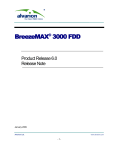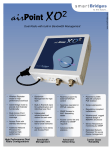Download BreezeMAX ® Extreme 5000
Transcript
® BreezeMAX Extreme 5000 Product Release 1.7 GA Release Note February 2011 © Alvarion Ltd. All rights reserved. The material contained herein is proprietary, privileged, and confidential. No disclosure thereof shall be made to third parties without the express written permission of Alvarion. Alvarion reserves the right to alter the specifications in this publication without prior notice. BreezeMAX Extreme 5000 Ver.1.7 Release Notes Page 1 of 15 General This document details the main hardware elements, software features, known limitations, bug fixes, and version compatibility information as well as the documentation available for the BreezeMAX Extreme 5000 product release 1.7. It corresponds to software versions: • Software version 1.7.1.35 of BreezeMAX Extreme 5000 base-station • Software version 1.7.2.5 of BreezeMAX PRO 5000 CPE The Product Released BreezeMAX Extreme is a state-of-the-art all-outdoor, all-in-one WiMAX 16e (IEEE 802.16e-2005) based platform, working in the 5.x GHz band, operating in TDD, and intended for worldwide use. BreezeMAX Extreme offers all the advantages of the WiMAX 16e to the license-exempt frequency bands. Leveraging the carrier class QoS along with the superior radio technology, formed in a small all-outdoor highly integrated design presenting an exceptionally attractive cost/performance ratio for various needs and deployment scenarios, improving operational costs and reducing complexity. The BreezeMAX Extreme base-station comes in two frequency configurations: • 4.9 model - supports 4.90-5.35 GHz • 5.4 model - supports 5.47-5.95 GHz The BreezeMAX Extreme PRO CPE covers the entire 1GHz band in a single model. With BreezeMAX Extreme release 1.7 the following country profiles are allowed for use, any other country profile is prohibited: 4.9 GHz Extreme model 5.4 GHz Extreme model (4.9-5.35) Universal Canada FCC ETSI 5.1 GHz FAA (5.47-5.95) Universal Canada Australia ETSI FCC Important notes: ONLY experienced installation professionals who are familiar with radio equipment for outdoor/indoor, local radio regulations, relevant local building and safety codes and, wherever applicable, are licensed by the appropriate government regulatory authorities should install outdoor units and antennas and should do so in accordance to the local regulations applicable. Due to the requirements of FCC regulations, starting with release 1.5.1.72, after setting the country code to FCC, it is not possible to further modify the country code to any other country band. BreezeMAX Extreme 5000 Ver.1.7 Release Notes Page 2 of 15 About this Release Release 1.7 of the BreezeMAX Extreme is based on release 1.5 and introduces enhancements and new features as well as new models. Release 1.7 introduces the following new elements and capabilities. Extreme BTS Product Models Supporting all the previously available models: • Single Sector SISO – A Single Input Single Output solution, serving a single sector, comes with either an integrated or an external antenna • Single Sector MIMO – A Multiple Input Multiple Output solution, serving a single sector, comes with either an integrated or an external antenna • Dual Sector SISO – A Single Input Single Output solution, serving two sectors, comes with an external antenna Extreme CPE Product Model Supporting previously released models: • Outdoor, MIMO CPE, 2Rx 1Tx, Integrated dual-slant antenna • Outdoor, MIMO CPE, 2Rx 1Tx, external antenna (2 N-Type connectors) End-to-end System Components New in this release: • A new power supply (indoor) for the CPE replacing the previous model New P/N Product 960004 Description XTRM-SU-IDU-1D BreezeMAX Extreme subscriber unit standard indoor unit BreezeMAX Data Bridge Indoor Module with one 10/100 Base-T Data Port. Cable to mains is NOT included and should be ordered separately. Replacing Part Number: 960001 • A new DC cable length supporting up to standard power for the Extreme 5000 base station P/N Description DC power cable for connecting 48V DC power source to the Extreme base station unit, 50m length. 935035 XTRM-CBL-DC-SP-50 Should be ordered with XTRM-CBL-DAT option or XTRM-CBL-BCKHL option connecting the Extreme to the backhaul data. The above cable is on top of the already available DC cables of SP-90 (standard power 90m), LP-30, and LP-50 (low power 30m and 50m). • Product IOT with Aradial AAA server (verified with version 5.2.3) Supporting also previous end-to-end elements: • All-outdoor Extreme BTS, with the following integrated capabilities o ASN-Gateway o GPS receiver o Integrated dual-slant antenna (external antenna model also available) BreezeMAX Extreme 5000 Ver.1.7 Release Notes Page 3 of 15 o Local provisioning option (no AAA mode) • PoE to feed the BTS • BTS cabling for power (PoE or DC), data, external antennas • GPS antenna kits (Basic and High-Profile models) • GPS Chaining cable (for multi sector site) • Sector Antennas (for external antenna model) • Outdoor CPE • PoE to feed the CPE • SAU – Subscriber Alignment Unit, for ease of installation and alignment of CPEs • AAA IOT: Radiator (verified with version 4.4), Alepo (verified with version 7), FreeRADIUS (verified with version 2.1.8) • ASN IOT: Integrated, external over R6 with 4Motion mini-centralized ASN • NMS: • o AlvariSTAR – Network Management System o StarACS – TR69 based CPE Management System Installer Aid: o AlvariCRAFT – Element Management and Installation Assistance Application Main Features The following new features and functionalities are supported with this release: • Extended DL/UL TDD Frame Ratios Support of additional DL/UL ratios (this is the WiMAX frame symbols allocation for DL/UL traffic): • DL/UL ratio of 35:65 for uplink oriented applications • DL/UL ratio of 75:25 for extensive downlink oriented applications The above are in addition to the 60:40 DL/UL ratio that is supported today. • Optimized video profile Support of a new optimized video service profile for video performance enhancement. This service profile aims to optimize the air link performance attuned to the video content (optimized for MPEG4-2). • Classification of the PPPoE traffic Support of DSCP with PPPoE classification option to support voice and data deployment within PPPoE encapsulated service. This allows customers that use PPPoE as their main provisioning scheme to support voice and data classification within the PPPoE service. • Support Alvarion BreezeMAX Wi2 Support of a new VLAN classifier (4096) that enables simplified Wi2 deployment using Extreme as the backhauling solution for the Wi2. • Support configurable “keep alive” interval of the AAA BreezeMAX Extreme 5000 Ver.1.7 Release Notes Page 4 of 15 Enabling the operator to modify the “keep alive” timeout interval of the AAA (between the AAA and the ASN in the BTS). This is important primarily when the connection between the AAA and the ASN over the backhaul is condensed (over subscription) or unreliable since AAA-ASN connectivity losses may affect the network stability. The value may range between 1.5 minutes (default value used previously) and up to once per day. • Enhanced Link Resilience and Control With release 1.7, several enhancements and tunings were done to the rate adaptation, as well as CPE - BTS link establishment and flow mechanisms (such as network entry, ranging, paging, etc) such that the link consistency and resilience are more robust. As part of these changes, several additional configuration options are available, such as: • o DLA mechanism – two options exists; one option (DLA2) is more conservative in rate selection (being less agile/aggressive) and is hence more attuned to interfered/noisy environments. o TCP enhancer –prioritizing the TCP ACKs such that the overall performance of TCP is enhanced. Support NGVG management in ACS (TR-069) Behind PRO-5000 With release 1.7, the newly introduced NG-VG solution (Part # 735108, a single indoor device, supporting 4 Eth ports, 2 voice ports, WiFi, and providing power connectivity to the outdoor CPE) can be managed with StarACS over TR-069 management protocol. Network Management Support Base Station Management The BreezeMAX Extreme base station is managed either by AlvariCRAFT as single element management (installer assistance), AlvariSTAR as a Network Management System or via Telnet. Release 1.7 of BreezeMAX Extreme Device is supported starting from Infrastructure version 4.7.0.147 of AlvariSTAR and AlvariCRAFT. AlvariSTAR Infrastructure 4.7.0.147 version has to be installed on AlvariSTAR platform with Extreme Device Driver 1.7.1.35 CPE Management The BreezeMAX PRO CPEs are managed either through a web interface for a single element management or over TR-69 using the StarACS CPE management system. Release 1.7 of BreezeMAX Extreme is supported starting StarACS version 3.1.7 BreezeMAX Extreme 5000 Ver.1.7 Release Notes Page 5 of 15 Documentation • • • • There are two major independent manuals, the BST System Manual and the CPEs Product Manual. Each manual covers all relevant topics associated with the respective equipment, including: o Product / system description o System installation o Commissioning o Operation and administration. The documentation includes the following: o BreezeMAX Extreme Base Station System Manual o BreezeMAX Extreme Base Station Quick Installation Guideline o BreezeMAX Extreme CPEs Product Manual o BreezeMAX Extreme CPE Quick Installation Guideline o BreezeMAX Extreme Traps and Alarms o AlvariSTAR User Manual (part of AlvariSTAR CD) o AlvariCRAFT User Manual (part of AlvariSTAR CD) The following documents are also updated with release 1.7: o BreezeMAX Extreme 5000 BTS Technical Specifications o BreezeMAX Extreme CPE PRO 5000 Technical Specifications o BreezeMAX Extreme Software Upgrade Procedure (to release 1.7) The following application/technical notes are also available with release 1.7: o Technical Note: Preparing cables for the BreezeMAX Extreme o Application Note: BreezeMAX Extreme operating with AAA o Application Note: BreezeMAX Extreme operation under local provisioning BreezeMAX Extreme 5000 Ver.1.7 Release Notes Page 6 of 15 Upgrading Software to Release 1.7 Please note that upgrading the software to release 1.7 involves several steps and recommendations. A dedicated document to cover the upgrade procedure for both BTS and the CPE is available. The following is a general description: • BTS upgrade to release 1.7 should include update of the firmware version as well as update of the Country Code configuration files (two files, named COUNTRY_CODES.sig and RFU_HEADS.sig); • CPE upgrade to release 1.7 from the 1.5 official release can be performed directly, without an intermediary version; • CPE upgrade can be performed either through the LAN or over the air; • Upgrading the Country Code files (COUNTRY_CODES.sig and RFU_HEADS.sig) as stated above is highly recommended in all cases Please refer to the software upgrade technical note for the step by step and further details on software upgrade procedure. NOTE: Due to FCC regulation requirements, starting with release 1.5.1.72 “FCC” country code is locked, namely: • When upgrading to release 1.5.1.72 or later releases with a unit set to “FCC” country code, the unit will be locked to FCC and you will not be able to change the country code to any value other than “FCC”. • When changing the country code to “FCC” in a unit running software version 1.5.1.72 or later, the country code will lock on “FCC” and no further changes of the country code will be allowed. BreezeMAX Extreme 5000 Ver.1.7 Release Notes Page 7 of 15 Supported Deployment Scenarios L o c a l P ro vis io n in g Centralized Provisioning Centralized Provisioning Integrated ASN-GW External ASN-GW DHCP Server DHCP Server AAA Server DHCP Server AAA Server IOT with: FreeRADIUS Radiator Aradial Alepo Bridgewater BTS can act as DHCP Server DHCP relay (opt. 82) DHCP trans. ASN Gateway IOT with: 4Motion Mini-Centralized Mixed Eth.CS and IP.CS Services Local Provisioning Distributed Integrated ASN External ASN Not required FreeRadius Radiator Alepo Aradial From 4motion portfolio: Alepo Bridgewaters Extreme Integrated Extreme Integrated 4Motion Mini-Centralized Fixed Fixed / Nomadic Fixed / Nomadic / Mobile* SU MAC (on BTS) User Name + Password User Name + Password None 16e based (keys by AAA) 16e based (keys by AAA) Eth. CS Yes Yes No IP CS Yes Yes Yes AAA ASN-GW Service Type Authentication / Provisioning Encryption *In future release BreezeMAX Extreme 5000 Ver.1.7 Release Notes Page 8 of 15 Recommendations / Important Notification When deploying the BreezeMAX Extreme 5000, please refer to the following recommendations: 1. Base Station ID configured in each channel must be unique in the entire network. Specifically when operating a dual-carrier BTS (e.g. 10+10) it is recommended to configure a unique BTS ID per each carrier to enable load-balancing. 2. The quality-of-service service profile configurations supported with this release are – BE (Committed Priority; CP=0), nRT (CP=1, 2 is supported), and eRT (CP=3 to 7). Suggested services configuration: a. Data: BE b. CPE Management (TR-069): nRT=1 c. Voice: eRT=5. 3. In the external AAA, the re-authentication timer (AK Life time) should be set to a value higher than 1hour. 4. When operating with external provisioning (AAA), if connectivity with AAA is lost the BTS will continue to function with previously authenticated MSs. When connection with AAA is reestablished the entire cell will be authenticated again (automatic de-registration of all CPE). 5. When working in IP-CS mode with a router behind the CPE, it is recommended to set the "Ethernet Downtime" on the CPE to be sufficient for the router to detect that the PHY is down and apply a DHCP renew – the value may vary between various router vendors. 6. The MAC address stated on the CPE label represents the LAN MAC address. The CPE WAN MAC address (used for instance for local provisioning of the SU) is according to the following rule: WAN MAC = LAN MAC + 1 7. When installing GPS antennas it is highly recommended to follow GPS antennas and receiver installation instruction and install the GPS antennas under clear sky. 8. When deploying a multi sector site it is recommended using a single high profile GPS antenna kit along with GPS chaining cable (CAT5e cable) between the base-station on the same site. 9. When performing software upgrade for the BreezeMAX Extreme CPE through the StarACS the behavior is as following: a. Software is downloaded to the unit b. Upon successful completion the unit set automatically "run from shadow" and performs reset itself. c. After link with BTS is established, the new version is Set as main automatically by the device 10. In case of using country code with DFS: We recommend using up-tilt kit for the CPE in case installed at the proximity of the base-station (typically in case of within 300m radius under CLOS) and adjust the up-tilt such that the max received signal from the CPE does not exceed -65dBm, this is to refrain from false DFS detection by the BTS. 11. DHCP server for the CPE management IP or the hosts behind the CPE should not contain the IP addresses pool range of 192.168.254.0 to 192.168.254.255. This is mainly since IP address 192.168.254.251/24 is the static local IP address (from the LAN) and as such reserves this subnet for local CPE provisioning. 12. When migrating a network from IP-CS to Eth-CS the following is recommended: a. Upgrade the entire network (CPE + BS) to release 1.2 or later b. Define new forwarding rule to be used with the Ethernet CS service BreezeMAX Extreme 5000 Ver.1.7 Release Notes Page 9 of 15 c. Define new service interface (as Eth.CS), associate to it the forwarding rule you've created in step 'b'. d. Update the desired Multiple Service Flows with the new service interface you have created. e. Update the Service Profile type per your needs (e.g. you may change the service from Data to PPPoE) f. De-register the MS to have the new setting in affect 13. In order to downgrade to release 1.1, all the service interfaces and services defined should be of IP-CS before the downgrade itself. 14. When working with External ASN-GW, please make sure that the networking device between the BTS and the ASN-GW supports MTU bigger than 1500 15. When using forwarding with option 82, if the Service Group gateway is a Cisco router the following configuration must be add on the Cisco to permit the DHCP packets to pass: “ip dhcp relay information trust-all“ 16. If additional devices are between the access router and BTS, these should forward without modification the DSCP marking. On CISCO switches the command is “mls qos trust dscp” 17. When using external DHCP servers, the default setting should be that the DHCP Offer is sent as broadcast (broadcast bit is set to 1). 18. After switching between Operation Modes (e.g. between a SINGLE-SECTOR-SINGLE-BS to SINGLESECTOR-DUAL-BS), please make sure you are updating the bandwidth and central frequency to the desired values (e.g. from 10MHz to 20MHz). 19. When a base-station operates in 20MHz (10+10MHz dual carrier) the actual used channels by each of the carriers is offset by ±BW/2. i.e. when operating with 10+10MHz (set in the BS as 20MHz), each one of the dual carriers would be ±5MHz than the configured central frequency. As the CPE is always operating with 10MHz the central frequency it should look for one of these BWs. 20. Due to FCC regulation requirements, starting with release 1.5.1.72 “FCC” country code is locked, namely: a. When upgrading to release 1.5.1.72 or later releases with a unit set to “FCC” country code, the unit will be locked to FCC and you will not be able to change the country code to any value other than “FCC”. b. When changing the country code to “FCC” in a unit running software version 1.5.1.72 or later, the country code will lock on “FCC” and no further changes of the country code will be allowed. 21. Please note, when downgrading from Release 1.7 to an older release, fields with extended range of values that are not supported in the old release, will be changed to the default parameter. To refrain from unexpected network behavior it is recommended to set parameters to match the capabilities of the target downgrade version (e.g. setting TDD ratio to 60:40 before downgrade to version 1.5). 22. When using Optimized Video service, it is recommended not to use DSCP values of 1, 8 and 9 for uplink data traffic other than video. Such DSCP values might interfere with the feature. 23. Please note that applying factory defaults will not change Country Code selection. Known Issues and Limitations With Release 1.7 described herein, the BreezeMAX Extreme 5000 system is introduced with the following limitations: BreezeMAX Extreme 5000 Ver.1.7 Release Notes Page 10 of 15 Base-Station 1. The Ethernet port supports only Auto Negotiation mode. 2. The quality-of-service service profile configurations supported with this release are – BE (with CP=0), nRT (with CP=1 or 2), and eRT (with CP=3 to 7). 3. 5GHz: 5725MHz frequency is not supported and should not be used. 4. The GPS synchronization may take up to 30min when installing the base station in a new location, installer may refer to the GPS Menus as detailed in the system manual 5. Upgrade to Release 1.7 involves also update of the following files: COUNTRY_CODES.sig, RFU_HEADS.sig, ODU_bands.sig 6. Ethernet CS is supported only with the Integrated ASN-Gateway. i.e. when working with external ASNGW only IP-CS services are supported. 7. As under PPPoE the accounting is typically performed by BRAS, Account Start and Account Stop messages are not sent under PPPoE service profile. 8. Any service modification requires MS de-registration in order to take place. 9. The same convergence sub-layer (either IP-CS or Eth-CS) should be used for all services on the MS. The only exception is the CPE management all the other services (either DATA, VOICE or PPPoE) should use the same convergence sub-layer. 10. IP addresses that are not learned through DHCP process when the service is IP CS will not be allowed to perform traffic. If static routes are added to a device acting as DHCP client the routed classes will not perform traffic. 11. Two service flows which have the same priority are equalized by the CPE at packet rates and not bit rates (the packet sizes are not taken into account). 12. 20 MHz (10+10) per a single sector is not applicable for 4.9 FCC and should not be used. 13. When performing backhauling over Extreme CPE (i.e. one Extreme base-station feeds an Extreme CPE associated to another Extreme BTS) the following considerations and limitation applies: a. Backhauling link must be under Eth.CS to ensure management of the bridged BTS b. Only Integrated ASN-GW can be used c. It is important to note that the QoS of the backhauling CPE must be set as such it can feed the necessary capacity to the second BTS d. It is important to design carefully the frequency allocations and potential bands (e.g. for the DCS, and BEST-BS-ID) of the two sectors (the feeding one and the bridged one). 14. Under GPS chaining, when there is a faulty chaining cable, the radio units in the chain may not initiate transmission. 15. Under GPS chaining the master presents GPS External 1PPS and External 10MHz as OK even if the GPS chaining cable is not connected. 16. Under 20 (10+10) MHz - When RF Channels are disabled, the operational status of the radio-channel is presented as Up. 17. Under dual sector SISO base-station, running a spectrum analyzer on one sector may lead as part of the scanning to BTS restart affecting the operation of the second sector. 18. When Number of Channels for Selection is equal with the number of frequencies from Usable Frequencies Table, the DCS will not measure the NI, it will choose randomly one frequency from that table 19. GPS holdover occurs if GPS signal is "lost" and eventually ends when GPS signal is reacquired. In case of frequent reoccurrences of GPS holdover events, the system may develop miss-synchronization BreezeMAX Extreme 5000 Ver.1.7 Release Notes Page 11 of 15 that may eventually require BTS reset. Recommended workaround is to minimize GPS holdover events – improving antenna installation location (insure clear sky), use high gain profile antenna 20. When running Spectrum Analyzer while operating in dual sector mode, if system had developed misssynchronization because of GPS holdover, at the end of the scan process the system would reinitialize both channels. 21. In very rare occasions, the logical BS ID might be reinitiated. This can be observed in the trap events as “No TX/RX” and deregistration of the CPEs associated to this BS ID. The situation is auto recoverable and service is restored after few seconds. 22. When BTS is operating with Release 1.5 or higher and cell range is default (40Km) the CPEs running release 1.2 or previous might fail to perform network Entry. Recommendation are: a. To refrain from such issues upgrade the network according to the SW upgrade procedure, first the CPE than the BTS. b. Recovery actions (in case BTS was upgraded to 1.5 or higher first): c. Upgrade also the CPE to Release 1.5 or higher to allow its association to the BTS d. Modify the cell range in the BTS to 8km would allow association of CPEs running 1.2 or previous firmware Newly Added with Release 1.7 24. When operating with ETH CS for Data, you need to set ETH-CS for Management as well, only VLAN classifiers can be used for the Data flows. 25. Although mentioned in recommendation #20, when operating in release 1.7 with Universal Country Code with DFS enabled, upon downgrade to release 1.5, the DFS parameter will remain enabled. 26. DSCP classifier cannot be matched if PPPoE session uses header compression. 27. If the BS Refresh feature is enabled and the network connection to the AAA is lost, user intervention is required in order to reinitialize the BTS device after the connection with the AAA server is reestablished. 28. Refreshing BS in a sector with up to one CPE associated is not effective. BreezeMAX Extreme PRO 5000 CPE 29. Ping messages of 25000 bytes transmitted over R1 (to the host behind CPE) are sometimes unanswered. There is no issue observed with Ping messages of length up to 14K bytes . 30. Software upgrade may fail if the WAN management IP is changed during the software upgrade process. 31. Sending IP fragmented packets between the MS and the BTS may result in packet loss. 32. Upgrade to Release 1.5 or higher from release 1.1 should be performed via an intermediate version. i.e. from release 1.1 (version 4.6.5.55) to intermediate version (1.2.0.3) and only than to official release 1.5 or higher. 33. When the sum of all provisioned services exceeds the CPE license capacity, the NE process will not be completed. The CPE will provision the services according to the order in which they are received until the license is exceeded. Newly added with Release 1.7 34. When operating with PPPoE service profile, the service lines cannot be configured with transparent VLAN 1P. 35. When installing DHCP servers on the Ethernet side of the CPE, the server can act only for the LAN . BreezeMAX Extreme 5000 Ver.1.7 Release Notes Page 12 of 15 36. Network entry timeout prevent s full band scan in universal CC, thus workaround is needed to set only one BW to scan. 37. DHCP process offers support for up to four hosts behind the CPE and it is recommended to use a router or network gateway when connecting additional Layer 2 devices behind the CPE. Issues Observed During Interoperability Testing ASN GW - General 1. When operating with an external ASN-GW following a service denial coming from the CPE, the CPE will be deregistered. Such cases might occur when using limited license CPEs and the total number of services defined for such a CPE is above the licensed value. Radiator AAA During the Interoperability test with Radiator version 4.4 the following issues were observed. Note that these can be overcome with additional scripts and configuration of the default installed Radiator AAA: 2. Multi-host support behind a single CPE might not work. One may need extra scripts to support multiple host creation in the AAA behind a single CPE. 3. In case of abrupt link termination between the ASN-GW and the AAA, account sessions might remain open (active). One may need to implement timers or other logic scripts in the AAA to close these sessions. FreeRADIUS AAA During the Interoperability test with FreeRADIUS version 2.1.8 the following issues were observed: 4. FreeRADIUS default installation (of version 2.1.8) requires modification of several configuration parameters (in different files) to be able to work properly with a WIMAX 16e solution such as the Extreme, for details on required changes please refer to the application note: "Application Note: BreezeMAX Extreme operating with AAA" 5. FreeRADIUS cannot be used together with external 4Motion mini-centralized ASN-GW ALEPO AAA During the Interoperability test with Alepo version 7, the following issue was observed: 6. In case of an abrupt link termination between the ASN-GW and the AAA, the account sessions might remain open (active). You may need to implement timers or other logic scripts in the AAA to close these sessions. ARADIAL AAA During the Interoperability test with Aradial version 5.2.3, the following issues were observed: 7. In case of an abrupt link termination between the ASN-GW and the AAA, the account sessions might remain open (active). You may need to implement timers or other logic scripts in the AAA to close these sessions. 8. Aradial default installation (of version 5.2.3) requires modification of several configuration parameters (in different files) to be able to work properly with a WIMAX 16e solution such as the Extreme. For details on the required changes, please refer to the application note: "Application Note: BreezeMAX Extreme operating with AAA". BreezeMAX Extreme 5000 Ver.1.7 Release Notes Page 13 of 15 Bug Fixes Release 1.7 described herein, introduces the following bug-fixes: Base-Station 1. BTS restart if External ASN operational mode is configured and unit management is done with VLAN tagged packets. 2. DHCP relay agent on the MS side does not receive an IP address for the served hosts. 3. Classification by VLAN ID = 4096 is not supported. 4. The PPPoE service uses EtherType classification only; any other configured classifier is ignored. 5. NE failure when provisioning a capacity limit CPE model with services sum exceeding the capacity limit. 6. Cases of CPE deregistration when forcing specific MCS with link adaptation disabled. 7. Cases in which BTS whith high level of traffic did not allow CPEs rate adaptation variations. 8. Software version integrity on the BTS (solved starting with upgrade to version 1.7 or later). CPE 9. CPE capacity license information is available through the WEB interface only. The information is not submitted through the TR069 protocol. 10. When operating with DHCP option 66 and 67, the CPE might not receive an IP if option 67 is not used (only 66) or if the option 67 xml file is not at the specified location. 11. ATPC cannot be disabled from the CPE web page. 12. License files must be based on the WAN MAC address. 13. The CPE will reboot if an incorrect URL is submitted through the management WEB page. 14. Cases in which the CPE is presented as linked, even though it is not. BreezeMAX Extreme 5000 Ver.1.7 Release Notes Page 14 of 15 Compatibility Matrix With Release 1.7 described herein, the following compatibility matrix applies: BMAX 5000 CPE ver. 1.7 BTS version CPE version 1.2/1.5/1.7.1.35 BMAX 4900 BST ver. 1.7 BMAX 5400 BST ver. 1.7 1.2*/1.5/1.7.2.5 1.2*/1.5/1.7.2.5 * may require configuring the BTS running 1.7 SW version to cell range of 8km Notes: • If any element (CPE or BTS) is not of the recent release (1.7) not all of release 1.7 functionality would be supported. • When downgrading to or working under a mixed version environment, it is important to use settings that are in the common denominator of both versions (e.g. if the CPEs are with release 1.5 or earlier you should not set a BTS running version 1.7 to use TDD ratios that are not supported by the earlier version CPEs). BreezeMAX Extreme 5000 Ver.1.7 Release Notes Page 15 of 15















